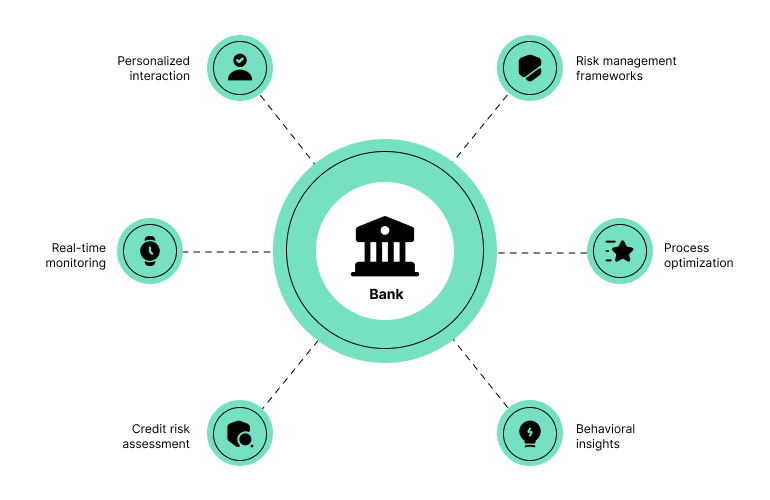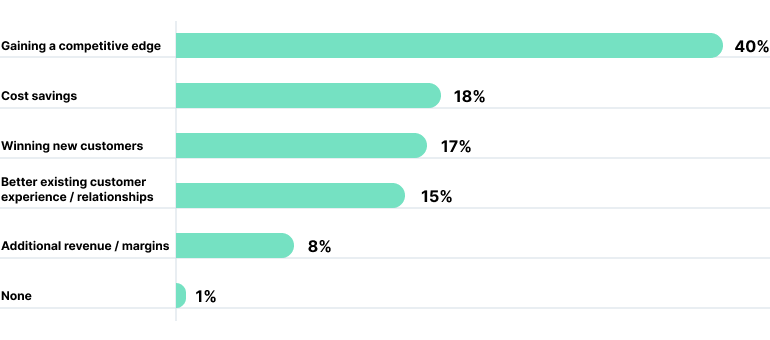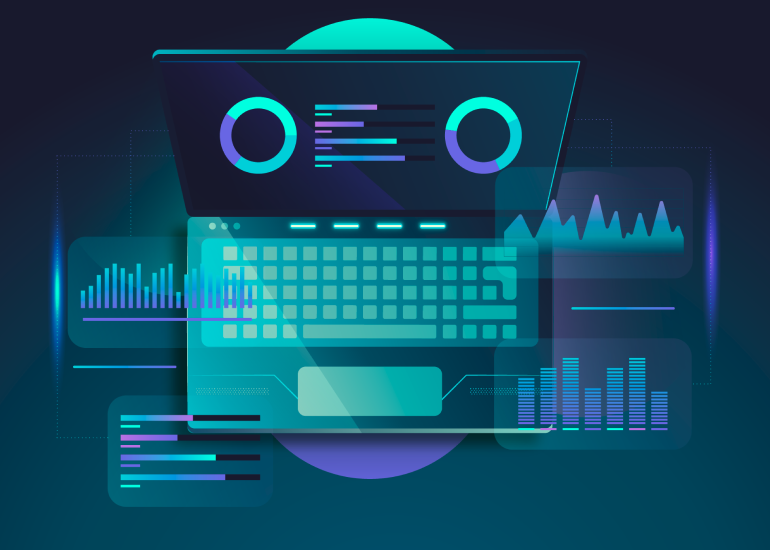Banks now run on data – from Main Street to Wall Street. Banking analytics technology helps retail banks spot spending patterns in millions of daily consumer transactions, while commercial divisions use it to assess business lending risks. Investment banking teams crunch market data to guide trading choices and merger deals. With trillions moving through the financial system each day, banks rely on data analysis to spot opportunities, catch fraud, and make smarter decisions across their retail, commercial and investment operations. Data analytics in banking has transformed the industry from traditional statistical modeling to sophisticated financial intelligence, fundamentally changing how banks understand markets, serve customers and manage risk.
Why it matters now
The financial industry has always been at the tip of the spear in data and analytics. But the real urgency now is expanding the analytical capabilities across the whole organization, rather than limiting it to a few specialized teams. Banks also need to make the most of both internal and external data, including unstructured sources, to remain relevant and resilient.
Modern banking analytics helps banks stay resilient in times of market volatility. That’s why data analytics in banking has become even more important. As banks move into the digital age, accurate and precise financial insights have become essential for survival. With 73% of global banking interactions now happening through digital channels (McKinsey & Company), banking data also helps them find new customers and offer innovative products.
On top of being a key tool for maximizing profitability KPIs and pro-growth approach, it is sharpening strategic risk and regulatory management. No wonder, big data analytics in the banking market is expected to reach $745.18 Billion by 2030 with a CAGR of 13.7%.
What is banking analytics?

Banking analytics is the systematic computational analysis of banking data to uncover patterns, relationships and insights that drive better business decisions. Think of it as a financial GPS – it not only shows the current state of things but also predicts the best route forward and warns of upcoming challenges. Banking data analytics is a strategic journey that transforms raw financial information into facts. It goes beyond outdated graphs, moving from data collection through its processing and analysis revealing what happened and why, ultimately building a foundation for concrete executive decisions. The process consists of four key components:
- Descriptive analytics: This focuses on understanding past financial patterns. It provides a snapshot of historical performance and brings out what has happened within banking operations.
- Diagnostic analytics: This delves into explaining variations in performance. By identifying the root causes behind financial trends, it answers the critical “why” questions in financial data.
- Predictive analytics: This looks ahead, forecasting future financial trends. It anticipates potential shifts in market and customer behavior, helping to shape proactive strategies for financial growth.
- Prescriptive analytics: This suggests strategic actions to take. It recommends specific operational and strategic interventions, guiding decision-making to achieve optimal business outcomes.
The Global Banking Annual Review 2024 points out that the key strategic dimensions of data analytics in banking —across retail banking, investment banking and corporate banking— include improving financial operations, understanding customer needs, optimizing banking processes and strengthening regulatory compliance.
As for the specifics, analytical techniques in banking focus on several areas. Fraud detection helps prevent financial misconduct. Risk management assesses and mitigates potential threats. Customer behavior analysis identifies clients’ patterns and preferences. Credit scoring evaluates financial risk. Personalized financial services tailor products to individual needs. Additionally, compliance monitoring ensures adherence to complex regulations, while developments in generative AI and advanced analytics create new opportunities for more sophisticated, targeted financial insights.
Benefits of data analytics for banking

Source: Innowise
Gone are the days when banking services were supported solely by personal relationships and gut instincts. While these still have their place, today, winning banks are differentiating themselves through careful segment selection and geographic positioning, precise value chain location and rigorous operations. The banking and financial services sector successfully integrate analytical approach to drive profitability and sustainable long-term growth in an increasingly complex industry setting. Fundamentally, data analytics in banking is a tool that brings some tangible benefits:
Strategic resilience to market volatility
At its core, banking data analytics allows financial organizations to identify patterns in a fluctuating environment. With empirical data insights, banks can spot and predict trends that might otherwise be unobvious. This clarity helps them respond to changes proactively, refine specific elements of the offer—product, pricing, channel and stay one step ahead of market shifts.
Revenue growth through better customer experience
Today’s banking customers demand more than basic transactions. Data analytics in banking helps turn standard services into personalized guidance creating authentic connections with customers. By analyzing individual 360-degree customer profiles, banks can better align their needs with the best targeted solutions as well as identify high-potential prospects. This understanding builds lasting relationships and revenues grow naturally.
Profit-driven operational models
The operational benefits from applying banking analytics are probably the most visible. Modern tools act like a sophisticated control room, monitoring everything from ATM maintenance needs to process bottlenecks and profitability. This means fewer service interruptions, faster transaction processing and more efficient resource use – all translating to a better service at lower costs.
Safer banking with intelligent risk protection
Risk management, traditionally one of banking’s biggest challenges, is seeing a major upgrade with analytical technology. Real-time fraud detection systems now act like an immune system for financial transactions, identifying and stopping suspicious activities before they can cause harm. Credit analytics has become more nuanced and accurate, leading to better lending decision-making that benefits both banks and borrowers.
Banking governance with data-based decisions
By integrating business analytics into daily operations, banking executives take a more precise approach to both management and compliance. Up-to-the-minute insights enable adaptable decisions based on current market conditions while keeping track of regulatory requirements. This direct visibility helps identify opportunities and challenges, leading to better revenue forecasts and sharper focus on profit drivers—all while sustaining strong financial performance.
From implementation to impact: use cases of banking analytics
The banking industry mirrors both external pressures and internal shifts, making accurate data essential for survival. From churn rates to strategic adaptability, analytics proves its worth when banks put their numbers to practical use.
Customer experience and personalization
The Netflix effect has reached banking – customers expect their bank to understand their habits and preferences. Data analytics in banking turns their standard services into a responsive relationship with each customer. It’s no longer just about meeting needs—it’s about anticipating them before they arise.
Bank of America stands out by offering seamless digital banking experience along with personalized financial advice, using data analytics in banking to boost customer engagement and retention. Their AI-driven tools, including personalized advice and the virtual assistant Erica, have led to 2.5 billion client interactions and engaged 58 million digital users, contributing to a 19% increase in earnings.
European banking and financial services innovator adopted advanced banking analytics to standardize data management across multiple countries and strengthen customer relations. By automating reporting and customer segmentation, the company reduced manual operations by 10% and improved decision-making, leading to a 20% increase in cost efficiency.
Citibank integrated banking analytics to improve clients’ omnichannel experience across every touchpoint. Using real-time data and AI insights helps target services more effectively and predict customer needs, which improves satisfaction and builds loyalty. Citibank now has 19 million active mobile users and over 25 million active digital users, reflecting a strong digital shift and higher engagement.
Swiss FinTech provider leveraged advanced analytics to transform personal banking. Their unified platform puts customers in control through smart account integration and real-time insights. It analyzes multi-bank transaction patterns and spending behaviors to deliver personalized budgeting tools, financial health scores and gamified engagement, helping users manage their credit portfolio, checking and insurance accounts.
Business growth and resilience

Banks use data to spot new business opportunities and prepare for market changes. By tracking customer behavior, competitive moves and economic signals, they can grow in strong markets and adapt quickly when conditions shift.
Austrian bank transformed its payment processing capabilities through advanced analytics, scaling to serve 2.5 million customers with 99.741% reliability. The platform’s real-time data streaming processes 3 million transactions per 8-hour period, enabling service delivery across 30,000 enterprises and 5 million mobile users.
German FinTech deployed data analytics for their banking platform, enabling secure 5-minute customer onboarding and real-time intelligence. The platform processes customer behavior patterns and transaction data to deliver personalized financial services, building a thriving marketplace community of over 500,000 participants.
TD Bank revolutionized its growth strategy by using data analytics in banking to analyze market potential, moving beyond intuition-based location selection to a predictive approach. After examining performance factors and behavioral data, the bank identified opportunities to optimize its branch network, potentially reducing its New York locations by 33% while improving customer service.
Fraud prevention and risk management
Banks shift from static rules to real-time risk management, identifying fraud patterns as they emerge. Banking analytics allows them to combine financial data with external signals to give a much sharper eye for spotting risks and understanding their financial impact.
DBS Bank in Singapore transformed its approach to risk management and fraud detection by using banking analytics. With AI-powered algorithms analyzing large amounts of data, the bank was able to save 17% more funds from scams by identifying potential threats faster and more accurately.
Germany’s first mobile-only bank integrated advanced data science algorithms into a secure microservice architecture, enhancing risk intelligence and user security. This allowed for real-time transaction monitoring, safe 60-second peer-to-peer transfers and automated spending insights, all while using verified data to protect financial information and transactions.
Consistent operational efficiency
Using internal data, social media and trends, integrated banking analytics tracks key metrics like cost-to-income ratios, return on assets and process cycle time. It measures performance, highlights inefficiencies and guides improvements while benchmarking against market standards.
A U.S. bank modernized its data infrastructure, focusing on data governance and banking analytics to boost security and operational efficiency. By centralizing metadata and automating workflows, the bank improved data visibility. It simplified onboarding and strengthened risk management, creating a more secure and efficient environment for processing financial information.
An Abu Dhabi digital bank applied banking analytics to make the operations faster, safer and more productive—boosting resource use by 20%. This data-driven approach helped optimize cloud storage, strengthen security and simplify daily processes, supporting management with a clear plan on how to drive growth and stay ahead of competitors.
The Bank of New York Mellon Corporation adopted banking analytics to sharpen its operational efficiency. With advanced data management solutions, BNY Mellon achieved 99.7% accuracy in account-closure validations and improved processing times by 88%.
Obstacles to implementing data analytics in banking

Banks are experimenting with technologies and business models to capitalize on new revenue streams. However, stepping outside traditional banking molds introduces greater business, reputational and regulatory risks. Like trying to renovate a house while people are living in it, implementing banking analytics comes with unique challenges.
Legacy systems integration
Many banks rely on outdated core systems that were built decades ago. These legacy systems often lack compatibility with modern analytics platforms, making integration difficult. This calls for a balanced approach to modernization, often involving middleware solutions, data lakes for storage and phased upgrades to minimize disruption.
Data quality and standardization
Data quality is a huge concern for banks, as fragmented and inconsistent data leads to poor decisions. To tackle this, banks need data integrity frameworks that go beyond the tech side—like automated data cleaning, management and regular audits. It’s also an organizational challenge, demanding a cultural shift so teams can align on data standards, ownership and governance.
Regulatory compliance
Regulatory compliance adds another layer of complexity. Banks must follow strict data privacy regulations (including GDPR and CCPA) or financial reporting (COREP/FINREP) while maintaining their analytical capabilities. Balancing this requires everything from strategic planning to thorough audits, and it becomes even more challenging when operating across different jurisdictions, each with its own regulatory framework.
Organizational and human factors
Skill gaps, a lack of data literacy and resistance to change can slow down the adoption of data analytics across departments. To get past these issues, banks need ongoing training, clear communication about how data analytics in the banking industry can drive value and a culture that values empirical decision-making.
Strategic implementation risks
High implementation and adoption costs, cybersecurity concerns and ethical issues around data can all create roadblocks. Banks also face uncertainty about the return on tech investments and change management at all levels. A clear, step-by-step strategy focusing on returns, responsible technology adoption and safety guidelines on top of a structured transformation is essential.
Steps for developing a successful banking analytics strategy
When developing a successful banking analytics strategy, the focus should always begin with clear business objectives, not just technology. Start by identifying the specific problems you’re trying to solve—whether it’s reducing fraud, improving customer retention or streamlining operations. Any data strategy will only work if aligned with business goals, providing a clear direction for the technology and processes needed. It can be broken down into phases for smoother implementation:
- Discovery and planning (2-3 months): Start with end in mind by auditing your systems, identifying quick wins and setting clear success metrics and ROI benchmarks. This phase sets the groundwork by understanding the current state and the gaps that need to be filled.
- Foundation building (3-6 months): Focus on creating your data infrastructure, implementing governance protocols and strengthening data security. This phase ensures that all the technical and organizational structures are in place for the strategy to actually work.
- Pilot program (2-3 months): Choose a high-impact use case and test the new system in a controlled environment. This helps refine the approach before a wider launch, minimizing risks.
- Scaled implementation (6-12 months): Once the pilot is successful, roll out the strategy across the organization. This phase includes system integration, full deployment and continuous optimization, ensuring that the strategy continues to deliver value.
Don’t just plan for today—design your banking analytics solution with a vision for tomorrow. Scalability is key at every step, ensuring your systems can support the changing needs of your banking business. Invest in the right talent, partner with a trusted data engineering services vendor and use change management to transform your organizational culture.
How Intellias can help
With Intellias, technological innovation isn’t just a theoretical concept or something limited to R&D. We apply our software engineering expertise in a practical and flexible way that becomes a core part of how you run your business. By guaranteeing data quality and integrity throughout its lifecycle, we help banks turn raw data into decision intelligence that drives profitability and boosts customer satisfaction. Our experienced teams combine banking industry knowledge with technical skills to make sure your analytics projects produce real results.
Full-cycle data management: Intellias builds a data ecosystem for each banking project to meet quality and compliance standards and improve analytics accuracy.
Advanced integration techniques: We use the newest data profiling tools to evaluate and clean data from various sources, ensuring consistency and reliability across all banking operations.
Automation for efficiency: Our automated workflows and DataOps services to smooth out data management tasks, minimizing manual errors and speeding up data processing.
Continuous monitoring: We conduct regular validation of data throughout its lifecycle to maintain high quality and provide reliable insights.
Robust data governance: Our strong data governance framework matches your existing infrastructure and processes to ensure compliance and promote accountability.
Business intelligence services: We help banks make use of all aspects of high-performance data intelligence with custom reporting analytics and visualization.
100+ data projects with real results: Our successful implementations help banks worldwide go beyond crunching numbers—they drive new levels of growth and innovation.
Contact our team of experts to explore how we can help you build data-driven banking operations for the future.
Building a Digital Bank. 12 Months from Concept to Realization.
Discover showcase



